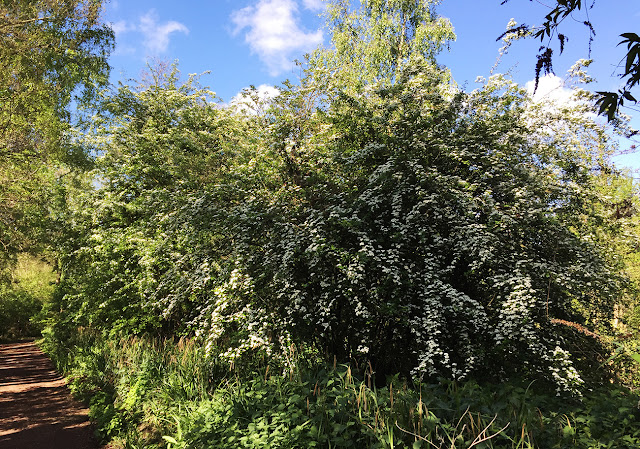 |
| Midland Hawthorn, Crataegus laevigata, and Common Hawthorn, Crataegus monogyna. Sevenoaks Wildlife Reserve, 25 April 2017. |
 |
| Midland Hawthorn, Crataegus laevigata, and Common Hawthorn, Crataegus monogyna. Flowers compared. 25 April 2017. |
Counting stigmas or pips is the only real way to be sure of these. Because, as is so often the case, you might also come across a hybrid between these two species, Crataegus x media, which has leaves and flowers intermediate between them. So on the hybrid, the flowers have mostly one, but sometimes two stigmas, and the pips in the berries follow suit. Here is one we found in May last year:
 |
| Hybrid Hawthorn, Crataegus x media. C. monogyna x C. laevigata. Near Jail Lane, 21 May 2016 |
Counting stigmas is MUCH easier than counting the pips, so this is the time of year to look for Midland or hybrid hawthorns them if you are so inclined. Coloured and double-petaled forms of the hybrid are sold as garden shrubs.
I found your blog because I wanted to find good places for insects near Bromley South Station (I live near there). Where would recommend for butterflies etc at this time of year? I do have a car but walking would be better.
ReplyDeleteThere are some excellent sites within an easy drive. The meadows at High Elms Country Park are 15 minutes away and you should find some nice species there, e.g. Dingy Skipper, Green Hairstreak, and later in the year, Silver-washed Fritillary and Marbled White. Downe Bank, with the same ecology, is certainly worth a look also but involves a walk as well as a drive. In summer, Jubilee Country Park is very good and it's also quite close. There are woods within walking distance, e.g. South Hill Wood on Westmoreland Road, and you should find Speckled Wood there. A bit further afield is Hutchinson's Bank where you can see Small Blue and Glanville Fritillary (that's an introduced colony but people travel long distances to see them) and the annual immigrant Clouded Yellow.
ReplyDeleteThank you very much I haven't had a chance to look yet but I will do soon.
ReplyDeleteYou are right about the speckled wood - one flew into my garden
ReplyDeletehttps://www.flickr.com/photos/14586608@N08/34713523904/in/photolist-UTvTfQ